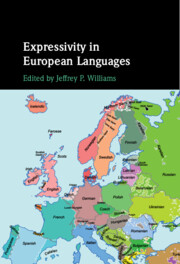Book contents
- Expressivity in European Languages
- Expressivity in European Languages
- Copyright page
- Contents
- Figures
- Tables
- Contributors
- 1 Introduction
- Uralic
- 2 Hypocoristic reduplications and embellished clippings in Hungarian and elsewhere
- 3 Reduplication in Finno-Ugric languages
- Germanic
- Hellenic
- Romance
- Celtic
- Vasconian
- Caucasian
- Comparative
- Index
- References
2 - Hypocoristic reduplications and embellished clippings in Hungarian and elsewhere
from Uralic
Published online by Cambridge University Press: 24 August 2023
- Expressivity in European Languages
- Expressivity in European Languages
- Copyright page
- Contents
- Figures
- Tables
- Contributors
- 1 Introduction
- Uralic
- 2 Hypocoristic reduplications and embellished clippings in Hungarian and elsewhere
- 3 Reduplication in Finno-Ugric languages
- Germanic
- Hellenic
- Romance
- Celtic
- Vasconian
- Caucasian
- Comparative
- Index
- References
Summary
The chapter focuses on two sets of items with hypocoristic function in Hungarian: 1. so-called embellished clippings, i.e. truncations that are subsequently furnished with one of the diminutive/endearment suffixes, such as Feri (Ferenc), Zoli/Zotya/Zotyi/Zolesz/Zolcso/Zoló (Zoltán), Kata/Kati/Kató (Katalin); 2. reduplications, typically consisting of two identical CV syllables. These can be based on first names, surnames, or some common nouns referring to people, denoting kinship relationships, profession, or property, e.g., Zozó (Zoltán), Zsozsó (Zsófia), Kokó (Kovács). Except for reduplications that are based on surnames, for all the others there is also at least one parallel hypocoristic form of the former type, i.e. an embellished clipping: Zoli/Zotya/Zotyi/Zolesz/Zolcso/Zoló – Zozó (Zoltán); Zsófi/Zsóca – Zsozsó (Zsófia). The goal of this chapter is to document the range of possibilities as well as to try to account for this peculiar distribution in the sense of which morphological processes interact with each other and in which order, but also in the sense of suggesting the factors that may have facilitated this state of affairs.
- Type
- Chapter
- Information
- Expressivity in European Languages , pp. 13 - 52Publisher: Cambridge University PressPrint publication year: 2023



